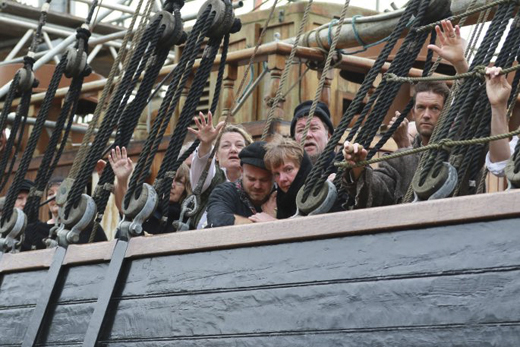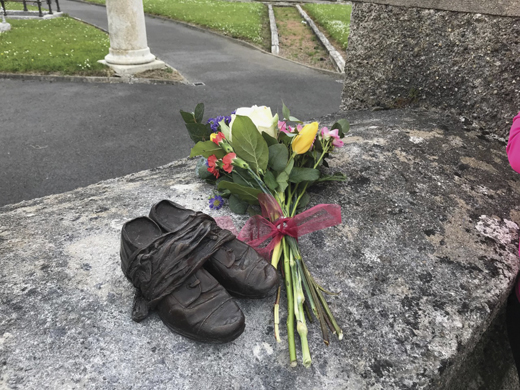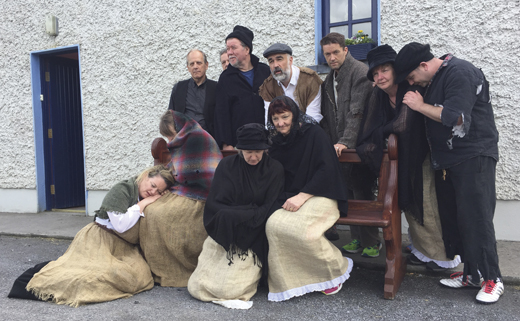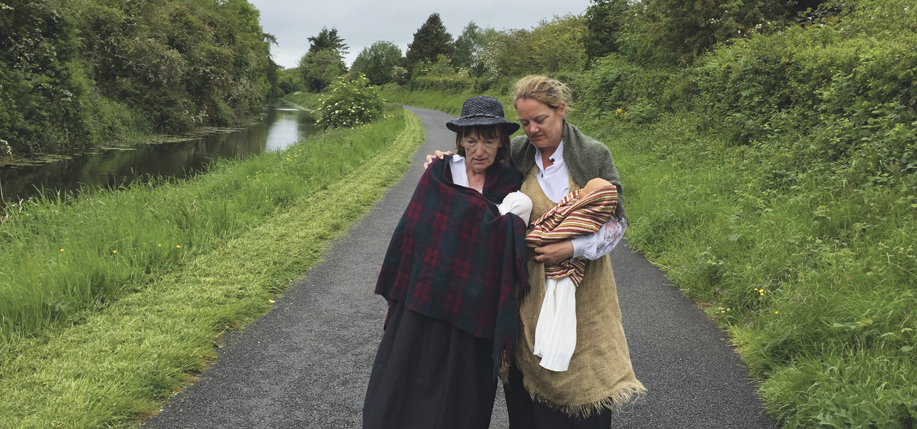Walking in the footsteps of 1,490 Irish exiled in 1847.
In 2017, and again in 2019, I was honored to be part of a small group of five historians who were invited by Caroilin Callery of the Irish Heritage Trust to follow in the footsteps of 1,490 refugees from the Great Hunger. As a historian, I have researched and written extensively about the Famine since completing my Ph.D. at Trinity College, Dublin in the 1980s. Nothing I have read in the intervening decades – and some accounts are heart-rending – has moved me as much as participating in these two walks.
Whose footsteps were we following?
In May 1847, when mortality was peaking in Ireland as a result of the arbitrary closing down of the public work schemes, almost 1,500 men, women, and children walked from County Roscommon to the quayside in Dublin. It was a journey of over 100 miles. What they had in common was that they all came from the Strokestown Estate and they had been tenants of Major Denis Mahon. “Had been”…as they had all been “persuaded” to surrender their small holdings in return for a free passage to Canada. For these poor people, emigration to Canada represented a voyage of survival; for Major Mahon, it was a calculated financial transaction.
Since the first failure of the potato crop in 1845, landowners had been clearing their estates, some more ruthlessly than others. Removing tenants overseas had the added attraction that they could never return and become occupants of the local workhouses, and thus a charge on local taxes. And the passage to Canada was cheaper than the one to America.
Thanks to the survival of the Mahon family papers at Strokestown House – and the intervention of local businessman, Jim Callery, who saved them – we are learning a lot more about these people. On the Canadian side, research is being undertaken by Professor Mark McGowan of Toronto University, who also took part in the 2019 walk.

The passenger list in the Strokestown archive reveals that 1,490 were sent to Canada in May 1847. One thousand of them were children. The group walked along the Royal Canal to Dublin. From there, they traveled onwards in several ships to Liverpool in the north of England.
In Liverpool, they boarded three separate ships to Canada, with the first stop being the quarantine station at Grosse Île. Over 600 of the 1,490 did not survive the journey.
When news of the deaths reached home, Mahon was condemned from the pulpit of the local Catholic church. Shortly afterwards, the landlord was assassinated. His death caused outrage in Britain and prompted Queen Victoria to write a letter of condolence. No sympathy was expressed for the dead 600.
The 2019 walk was the third one to take place. Additionally, this year marked the launch of the National Famine Way along the Royal Canal. The Famine Way is marked by 31 pairs of bronze children’s shoes, some of which were unveiled during the walk. They each have a short story written by Marita McConlan-McKenna, describing the journey from the perspective of a 12-year-old boy. We stopped at each of these monuments for a moment of quiet reflection.
The 2019 walk took place over seven days. On the first day we did not walk but participated in a “Canadian Wake” in Strokestown. The next day we began walking. As we left Strokestown, pupils from the local Scoil Mhuire read a roll call of the names of the 1,490. Each walker assumed the persona of one of the original emigrants. I was Bridget Brennan, and was traveling with my husband and two children. Both I and one of my children (unidentified) died at Grosse Île. So, I (as Bridget) never saw Canada – a reminder that Famine deaths were not confined to Ireland.
At a number of points along the canal we were joined by local people who accompanied us for a few steps or a few miles. This included a large number of schoolchildren, reminding us that many of the original walkers were aged under 12. At one point, we were joined by a large group of refugees and asylum seekers from the New Horizon Group in Athlone, a timely reminder of why we should not forget our history.

There were a number of particularly poignant moments. This included the final sight of Sliabh Bawn, the beautiful mountain that many families had lived on. As we left Mullingar, we were joined by 300 schoolchildren and by a local uilleann pipe player. Piper Colgan played a sad lament as we left the town behind us. He was re-creating what had happened in the 1830s and 1840s when local pipers would come out to give a musical farewell to emigrants. It may have been the last time they ever heard Irish music. The place where the farewell music was performed became known as “The Piper’s Boreen” (Boithrin an Phiobaire).
For the great majority of the walk there were just six of us, allowing plenty of time for quiet reflection. In the 1840s, though, the canals would have been bustling with activity and full of noises and smells. Horses and people would have packed the tow paths, and barges would be constantly traversing up and down the canals, many of those heading to Dublin carrying food that was being exported out of Ireland. In Mullingar, the Strokestown people would have had their first sighting of a train, as railways were expanding westwards. Being confronted with so much that was unknown must have been an overwhelming experience at times.
In the 1840s, sailing to Canada would take approximately six weeks. Many of the 800 who survived the journey were children, a large portion of whom had been orphaned. Several of them were adopted by French-Canadian families. This happened to 12-year-old Daniel Tighe, who had lost his mother, his uncle, and three siblings during the journey. He and his younger sister were adopted by a childless French-Canadian couple. In 2013, Daniel’s descendant, Richard Tye, returned to Strokestown. There, he was reunited with his Tighe relatives. Richard had never left Canada before, and he spoke no English. The loss of family, home,
language, and culture were all part of the tragedy of the Famine.
In total, we walked for six days along the Royal Canal. When we arrived in Dublin, we boarded the Jeanie Johnston (a Famine replica tall ship) and we symbolically said goodbye to Ireland.

We then had a closing event in the Epic
Museum of Emigration. Singer Declan O’Rourke and sculptor Kieran Tuohy joined us there. We had made it!
Over the course of the seven days, the camaraderie, the craic, the knowledge, and the kindness of the group was incredible. The walk was physically and emotionally draining, but we each helped each other through it. We walked whatever the weather: the first day was hot, leading to some sunburn; the third day we had freezing rain and hail stones – and nowhere to shelter. And there were many blisters, broken toenails, and aching legs and backs. But there was no real hardship – we had food, water, beds, showers and soap, blister pads, and no small, hungry children to carry…
Walking in the footsteps of the exiled 1,490 has been a highlight of my professional and personal life. Thanks to the vision and doggedness of the Callery family, the “missing 1,490” are no longer missing or forgotten. Moreover, their stories are a microcosm of the stories of the millions of people who fled from Ireland in the 19th century.
As we walked, I would
frequently wonder: what was it like to be a refugee in 1847, leaving behind your home, your community and your country? Perhaps, just as importantly, what is it like to be a refugee in 2019?
As one of the walkers pointed out, “Our past is their present.” ♦


Everyone should read this article. It is beautifully written and recalls a dark time in history that many of us know little or nothing about. Thank you for writing this article.